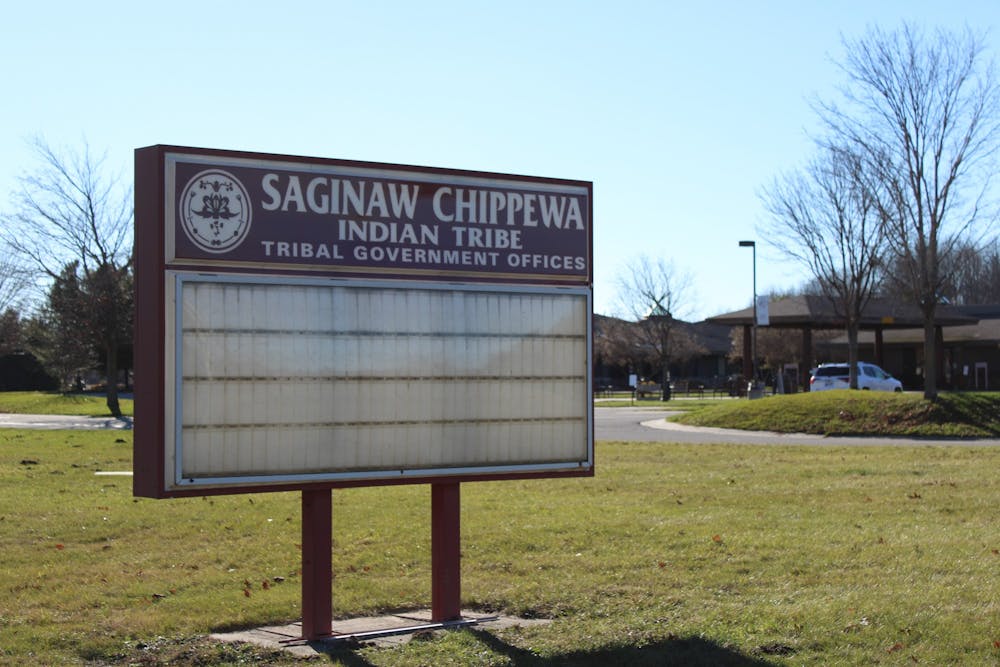Saginaw Chippewa Indian Tribe distributes $2 million grant to local governments, schools
On Nov. 18 Saginaw Chippewa Indian Tribe (SCIT) announced the distribution of the 2 percent grant to local government agencies and schools' projects.
Erik Rodriguez, public relations director for the SCIT, said the grant has been around for 28 years. It helps establish relationships with local governments and school districts, and helps to meet the needs of citizens.
“We are very humbled and grateful for the opportunity to give back to our communities,” Rodriguez said. “It’s a large part of what we do here locally. I think the need to be able to take care of those who take care of us and show that we are great community partner, to make this region a great place to live.”
History of 2 percent
The 2 percent grant was started in 1993, the result of a lawsuit between the SCIT, six other tribes in Michigan with the state of Michigan.
The lawsuit was about the gaming compact, an agreement between the Indian tribes and the state of Michigan over gaming and casino operations. The state asked the tribes to pay 10 percent of the net gaming revenues from class III gaming (includes casinos and slot machines) in exchange for exclusivity (that only those casinos are in the state).
Rodriguez said SCIT did not want to pay all 10 percent to the state fund. Rather, SCIT wanted to make sure some of that money was seen locally.
“When you put money into the general fund, it goes to our larger cities, to Detroit, to Grand Rapids, to Ann Arbor, and very little as seen by our local community,” Rodriguez said. “We wanted to negotiate in good faith that 2 percent would remain local here, and 8 percent would then (go) to the state funds.”
The state accepted that condition, he said.
SCIT pays two percent of their casino operation to the local governments (which included seven townships, city of Mount Pleasant and Isabella County). The federal court order requires the tribes to pay 2 percent to the local community twice a year and 8 percent to the state, Rodriguez said.
Rodriguez said that in 1993, the state of Michigan violated the agreement. The state entered the compacts with two other tribes that were not among the initial seven in the agreement, violating the promise of exclusivity.
SCIT stopped paying the 8 percent obligation to the state fund, but the Tribe still wanted to give its local distribution. The 2 percent grant has been paid since the spring of 1994. Over the years, SCIT paid over $227 million to local governments and schools, Rodriguez said.
Who is eligible for the grant?
“We were required to pay local units of government. But we understood that locally there was a much larger impact,” Rodriguez said. “So, we wanted to put this to the local education districts and the school districts to be able to get a portion of this money.”
He said the local government entities that are eligible for the grant are: Union, Deerfield, Wise, Denver, Isabella, Nottawa and Chippewa townships, the City of Mount Pleasant and Isabella County.
Local school districts that are eligible for the grant are: Beal City, Chippewa Hills , Mount Pleasant and Shepherd public schools, Renaissance Public School Academy and Gratiot-Isabella RESD.
Private schools, nonprofits or any townships that are outside of the boundaries do not qualify for the grant.
Rodriguez said the grant amount is not fixed, but is based on the revenues from the previous six-month period. The distributions are made in May and November; the grant goes toward the approved projects.
Requestors should submit an application on the SCIT website. “It’s a pretty easy application, user-friendly,” Rodriguez said.
The deadlines for applications are March 31 for spring distributions and Sep. 30 for fall.
Authorizers will be asked to describe their project and location, and to rate it on a scale of critical, high, medium and low.
Rodriguez said each cycle SCIT gets from 250 to 465 applications.
The applications are reviewed by a Tribal Council, a SCIT governing body of 12 elected leaders (leaders get elected every two years). The council reviews each request and decides how they want to distribute funds for those cycles.
The Council also communicates with the education board, law enforcement, fire chief, city or county commissioners so that they give a rating from critical to low on the related matters. Rodriguez said it gives an idea of what community is looking for. The council rates the requests as well.
About three years ago, local government agencies started to be invited to informal grant distribution roundtable discussions. Rodriguez said it helps to better understand the needs of the community, the project and impacts of the grant.
Rodriguez said grants usually go towards infrastructure (roads, culverts and drains, for example), public safety (vehicles or equipment for police or fire departments) and environmental requests (such as county recycling, recreation projects, community wellness and parks).
The Council decides how to distribute the grant based on community needs, trends, matching funds and partnerships.
Rodriguez provided an example of a Protect Yourself program in a combination with Isabella County Child Advocacy Center through public school system. The program teaches first graders in the Isabella County about safety, how to protect their bodies and look out for sexual predators.
“We want to make sure that if we can award a project, it can be used, and then we can see meaningful impacts of these dollars locally,” Rodriguez said. “We understand that we’re probably the leader of tourism along with Central Michigan University here locally, so we have a huge impact of bringing people on all of our local roads.
"We feel this helps alleviate the need. And we’re not putting that back on taxpayers of the local area, but assisting in making sure that the local government agencies and the schools get some of those resources.”
Who received the grant this fall?
On Nov. 18, SCIT announced more than $2.4 million in grants, Rodriguez said. Recipients, and their projects, were:
- Isabella County received $481,474 to go toward recycling programs, Herrick Park playground project and the On Aging project.
- The city of Mount Pleasant received $325,000 for the Mill Pond Dam replacement, fire rescue apparatus and 1303 N. Franklin Former Landfill remediation and monitoring project.
- Chippewa Township received $127,850.85 for Shepherd Road from River Road to Baseline Road project and general allocation.
- Deerfield Township received $105,818.94 for a Broomfield Road project, wildland fire suppression skid unit and general allocation.
- Denver Township received $240,579.88 for a Loomis Road project and general allocation.
- Isabella Township received $48,011.82 for park renovations and updates and general allocation.
- Nottawa Township received $4,353.82 to go toward a general allocation.
- Union Township received $170,000 for a Broomfield Road project.
- Village of Shepherd received $216,000 for a pedestrian bridge project.
- Wise Township received $7,481.82 for garbage costs for tribal members and general allocation.
- Beal City Public Schools received $71,413.09 for safety classes, books and field trips.
- Chippewa Hills Public Schools received $129,867 for playground equipment, a Warrior logo exchange and rebranding projects.
- Mount Pleasant Public Schools received $248,713.56 for school safety counts, school building emergency radios, Protect Yourself program, support for students at risk, books, field trips and other projects.
- Shepherd Public Schools received $108,265.40 for School Safety First, Central Office Safety, emergency medical equipment and other projects.
- Gratiot-Isabella RESD received $52,100 for a library and a nature area.
- Renaissance Public School Academy received $129,600 for a new school sign on Isabella Road, band concerts, the Renaissance gardening and homesteading program and others.
Additionally, the Saganing Tribal Center distributed over $1.1 million to Arenac County, the cities of AuGres, Omer, Pinconning and Standish, their 12 townships and two fire departments.
Rodriguez said this year with the help of grant he hopes to “alleviate some of the financial burden to our local residents to make sure we’re giving resources to our community that may not be accessible through other means or other funding opportunities.”
Last November, more than $2.6 million was distributed on behalf of the 2 percent grant --70 percent of money went to governments and 30 percent to schools. Last spring, over $2.3 million was granted -- 75 percent to governments and 25 percent to schools.
Distribution ceremonies can be viewed on the SCIT website.







